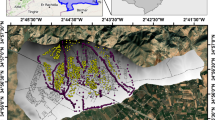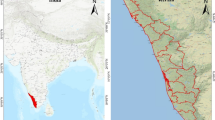Abstract
Human activities in many parts of the world have greatly changed the natural land cover. This study has been conducted on Pichavaram forest, south east coast of India, famous for its unique mangrove bio-diversity. The main objectives of this study were focused on monitoring land cover changes particularly for the mangrove forest in the Pichavaram area using multi-temporal Landsat images captured in the 1991, 2000, and 2009. The land use/land cover (LULC) estimation was done by a unique hybrid classification approach consisting of unsupervised and support vector machine (SVM)-based supervised classification. Once the vegetation and non-vegetation classes were separated, training site-based classification technology i.e., SVM-based supervised classification technique was used. The agricultural area, forest/plantation, degraded mangrove and mangrove forest layers were separated from the vegetation layer. Mud flat, sand/beach, swamp, sea water/sea, aquaculture pond, and fallow land were separated from non-vegetation layer. Water logged areas were delineated from the area initially considered under swamp and sea water-drowned areas. In this study, the object-based post-classification comparison method was employed for detecting changes. In order to evaluate the performance, an accuracy assessment was carried out using the randomly stratified sampling method, assuring distribution in a rational pattern so that a specific number of observations were assigned to each category on the classified image. The Kappa accuracy of SVM classified image was highest (94.53 %) for the 2000 image and about 94.14 and 89.45 % for the 2009 and 1991 images, respectively. The results indicated that the increased anthropogenic activities in Pichavaram have caused an irreversible loss of forest vegetation. These findings can be used both as a strategic planning tool to address the broad-scale mangrove ecosystem conservation projects and also as a tactical guide to help managers in designing effective restoration measures.





Similar content being viewed by others
References
Bala Krishna Prasad M, Ramanathan A, Alongi D, Kannan L (2006) Seasonal variations and decadal trends in concentrations of dissolved inorganic nutrients in Pichavaram mangrove waters, southeast India. Bull Mar Sci 79(2):287–300
Bazi Y, Melgani F (2006) Toward an optimal SVM classification system for hyperspectral remote sensing images. IEEE Trans Geosci Remote Sens 44(11):3374–3385
Bishop YM, Fienberg SE et al. (2007) Discrete multivariate analysis theory and practice. MIT Press, Cambridge
Borges A, Djenidi S, Lacroix G, Théate J, Delille B, Frankignoulle M (2003) Atmospheric CO2 flux from mangrove surrounding waters. Geophys Res Lett 30(11):1558
Census Data (1991) Directorate of Census. Government of India, Tamil Nadu
Census Data (2001) Directorate of Census. Government of India, Tamil Nadu
Dixon B, Candade N (2008) Multispectral landuse classification using neural networks and support vector machines: one or the other, or both? Int J Remote Sens 29(4):1185–1206
Donato D, Kauffman J, Mackenzie R, Ainsworth A, Pfleeger A (2012) Whole-island carbon stocks in the tropical Pacific: implications for mangrove conservation and upland restoration. J Environ Manage 97:89–96
Foody GM, Mathur A (2004) A relative evaluation of multiclass image classification by support vector machines. IEEE Trans Geosci Remote Sens 42(6):1335–1343
Green K, Kempka D, Lackey L (1994) Using remote sensing to detect and monitor land-cover and land-use change. Photogramm Eng Remote Sens 60(3):331–337
Gupta M, Srivastava PK (2010) Integrating GIS and remote sensing for identification of groundwater potential zones in the hilly terrain of Pavagarh, Gujarat, India. Water Int 35(2):233–245. doi:10.1080/02508061003664419
Hua S, Sun Z (2001) Support vector machine approach for protein subcellular localization prediction. Bioinformatics 17(8):721–728
Huang C, Davis L, Townshend J (2002) An assessment of support vector machines for land cover classification. Int J Remote Sens 23(4):725–749
Islam T, Rico-Ramirez MA, Han DW, Srivastava PK (2012) Artificial intelligence techniques for clutter identification with polarimetric radar signatures. Atmos Res 109:95–113. doi:10.1016/j.atmosres.2012.02.007
Jensen JR (1996) Introductory digital image processing: a remote sensing perspective, 2nd edn. Prentice-Hall Inc, New Jersey
Kavzoglu T, Colkesen I (2009) A kernel functions analysis for support vector machines for land cover classification. Int J Appl Earth Obs Geoinf 11(5):352–359
Keuchel J, Naumann S, Heiler M, Siegmund A (2003) Automatic land cover analysis for Tenerife by supervised classification using remotely sensed data. Remote Sens Environ 86(4):530–541
Lau K, Wu Q (2008) Local prediction of non-linear time series using support vector regression. Pattern Recogn 41(5):1539–1547
Li D-C, Liu C-W (2010) A class possibility based kernel to increase classification accuracy for small data sets using support vector machines. Expert Syst Appl 37(4):3104–3110
Lillesand TM, Kiefer RW, Chipman JW (2004) Remote sensing and image interpretation, 5th edn. John Wiley & Sons Ltd, New York
Mouat DA, Mahin GG, Lancaster J (1993) Remote sensing techniques in the analysis of change detection. Geocarto Int 8(2):39–50
Mukherjee S (2004) Textbook of environmental remote sensing. Macmillan India Ltd, New Delhi
Mukherjee S, Shashtri S, Singh C, Srivastava PK, Gupta M (2009) Effect of canal on land use/land cover using remote sensing and GIS. J Indian Soc Remote Sens 37(3):527–537
Otukei J, Blaschke T (2010) Land cover change assessment using decision trees, support vector machines and maximum likelihood classification algorithms. Int J Appl Earth Obs Geoinf 12:S27–S31
Pal M, Foody GM (2010) Feature selection for classification of hyperspectral data by SVM. IEEE Trans Geosci Remote Sens 48(5):2297–2307
Pal M, Mather P (2004) Assessment of the effectiveness of support vector machines for hyperspectral data. Future Gener Comput Syst 20(7):1215–1225
Patel D, Dholakia M, Naresh N, Srivastava PK (2012) Water harvesting structure positioning by using geo-visualization concept and prioritization of mini-watersheds through morphometric analysis in the lower Tapi basin. J Indian Soc Remote Sens 40(2):299–312. doi:10.1007/s12524-011-0147-6
Patel DP, Gajjar CA, Srivastava PK (2013) Prioritization of Malesari mini-watersheds through morphometric analysis: a remote sensing and GIS perspective. Environ Earth Sci 69:2643–2656
Petropoulos GP, Kontoes C, Keramitsoglou I (2011) Burnt area delineation from a uni-temporal perspective based on Landsat TM imagery classification using Support Vector Machines. Int J Appl Earth Obs Geoinf 13(1):70–80
Prasad MBK, Ramanathan A (2008) Distribution of rare earth elements in the Pichavaram mangrove sediments of the southeast coast of India. J Coastal Res 24(sp1):126–134
Ranjan RK, Ramanathan A, Singh G (2008) Evaluation of geochemical impact of tsunami on Pichavaram mangrove ecosystem, southeast coast of India. Environ Geol 55(3):687–697
Ranjan RK, Routh J, Ramanathan A (2010) Bulk organic matter characteristics in the Pichavaram mangrove–estuarine complex, south-eastern India. Appl Geochem 25(8):1176–1186
Sanchez-Hernandez C, Boyd DS, Foody GM (2007) Mapping specific habitats from remotely sensed imagery: support vector machine and support vector data description based classification of coastal saltmarsh habitats. Ecol Inform 2(2):83–88
Song C, Woodcock CE, Seto KC, Lenney MP, Macomber SA (2001) Classification and change detection using Landsat TM data: when and how to correct atmospheric effects? Remote Sens Environ 75(2):230–244
Srivastava PK, Mukherjee S, Gupta M (2008) Groundwater quality assessment and its relation to land use/land cover using remote sensing and GIS. In: Proceedings of international groundwater conference on groundwater use—efficiency and sustainability: groundwater and drinking water issues, Jaipur, India, pp 19–22
Srivastava PK, Mukherjee S, Gupta M (2010) Impact of urbanization on land use/land cover change using remote sensing and GIS: a case study. Int J Ecol Econ Stat 18(S10):106–117
Srivastava PK, Gupta M, Mukherjee S (2012a) Mapping spatial distribution of pollutants in groundwater of a tropical area of India using remote sensing and GIS. Appl Geomat 4(1):21–32. doi:10.1007/s12518-011-0072-y
Srivastava PK, Kiran G, Gupta M, Sharma N, Prasad K (2012b) A study on distribution of heavy metal contamination in the vegetables using GIS and analytical technique. Int J Ecol Dev 21(1):89–99
Srivastava PK, Han D, Gupta M, Mukherjee S (2012c) Integrated framework for monitoring groundwater pollution using a geographical information system and multivariate analysis. Hydrol Sci J 57(7):1453–1472. doi:10.1080/02626667.2012.716156
Srivastava PK, Han D, Rico-Ramirez MA, Bray M, Islam T (2012d) Selection of classification techniques for land use/land cover change investigation. Adv Space Res 50(9):1250–1265. doi:10.1016/j.asr.2012.06.032
Srivastava PK, Singh S, Gupta M, Thakur JK, Mukherjee S (2012e) Modeling impact of land use change trajectories on groundwater quality using remote sensing and GIS. Environ Eng Manage J (in press)
Szuster BW, Chen Q, Borger M (2011) A comparison of classification techniques to support land cover and land use analysis in tropical coastal zones. Appl Geogr 31(2):525–532
Thakur J, Srivastava PK, Singh S, Vekerdy Z (2012) Ecological monitoring of wetlands in semi-arid region of Konya closed Basin, Turkey. Reg Environ Change 12(1):133–144. doi:10.1007/s10113-011-0241-x
Tong S, Chang E (2001) Support vector machine active learning for image retrieval. In: Proceedings of the ninth ACM international conference on multimedia. ACM, New York, pp 107–118
Vapnik VN, Chervonenkis AY (1971) On the uniform convergence of relative frequencies of events to their probabilities. Theory Probab Appl 16(2):264–280
Waske B, Benediktsson JA (2007) Fusion of support vector machines for classification of multisensor data. IEEE Trans Geosci Remote Sens 45(12):3858–3866
Yao X, Tham L, Dai F (2008) Landslide susceptibility mapping based on support vector machine: a case study on natural slopes of Hong Kong, China. Geomorphology 101(4):572–582
Zhu G, Blumberg DG (2002) Classification using ASTER data and SVM algorithms: the case study of Beer Sheva, Israel. Remote Sens Environ 80(2):233–240
Acknowledgments
Authors are highly thankful to Directorate of Census (Tamil Nadu division), Government of India, for providing the necessary reference data and HOD of K.Banerjee Centre of Atmospheric and Ocean Studies, Nehru Science Centre, IIDS, University of Allahabad, Allahabad-211002, India for their support throughout the project.
Author information
Authors and Affiliations
Corresponding author
Rights and permissions
About this article
Cite this article
Singh, S.K., Srivastava, P.K., Gupta, M. et al. Appraisal of land use/land cover of mangrove forest ecosystem using support vector machine. Environ Earth Sci 71, 2245–2255 (2014). https://doi.org/10.1007/s12665-013-2628-0
Received:
Accepted:
Published:
Issue Date:
DOI: https://doi.org/10.1007/s12665-013-2628-0




